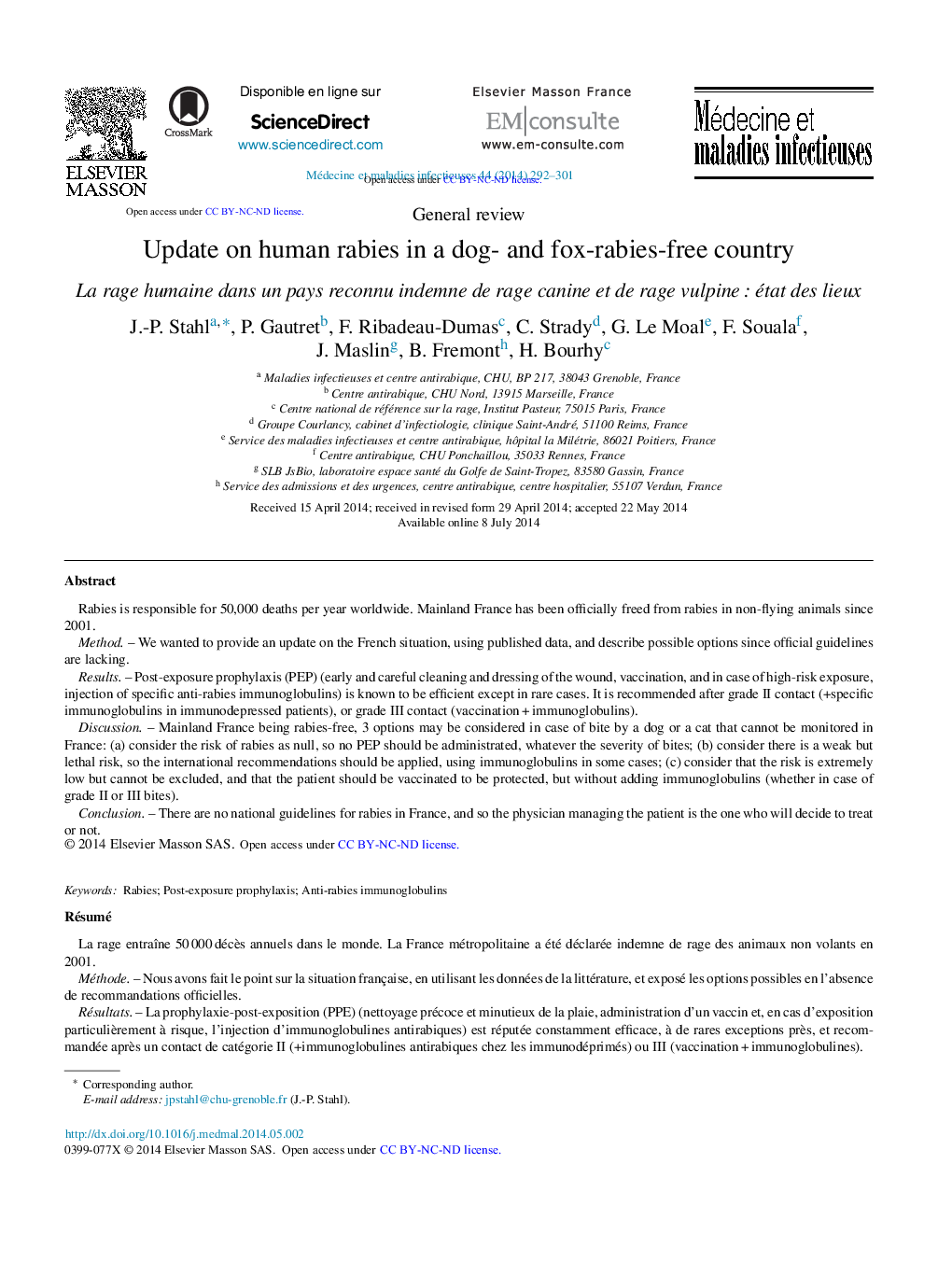| کد مقاله | کد نشریه | سال انتشار | مقاله انگلیسی | نسخه تمام متن |
|---|---|---|---|---|
| 6135501 | 1224242 | 2014 | 10 صفحه PDF | دانلود رایگان |

Rabies is responsible for 50,000 deaths per year worldwide. Mainland France has been officially freed from rabies in non-flying animals since 2001.MethodWe wanted to provide an update on the French situation, using published data, and describe possible options since official guidelines are lacking.ResultsPost-exposure prophylaxis (PEP) (early and careful cleaning and dressing of the wound, vaccination, and in case of high-risk exposure, injection of specific anti-rabies immunoglobulins) is known to be efficient except in rare cases. It is recommended after grade II contact (+specific immunoglobulins in immunodepressed patients), or grade III contact (vaccination + immunoglobulins).DiscussionMainland France being rabies-free, 3 options may be considered in case of bite by a dog or a cat that cannot be monitored in France: (a) consider the risk of rabies as null, so no PEP should be administrated, whatever the severity of bites; (b) consider there is a weak but lethal risk, so the international recommendations should be applied, using immunoglobulins in some cases; (c) consider that the risk is extremely low but cannot be excluded, and that the patient should be vaccinated to be protected, but without adding immunoglobulins (whether in case of grade II or III bites).ConclusionThere are no national guidelines for rabies in France, and so the physician managing the patient is the one who will decide to treat or not.
RésuméLa rage entraîne 50 000 décès annuels dans le monde. La France métropolitaine a été déclarée indemne de rage des animaux non volants en 2001.MéthodeNous avons fait le point sur la situation française, en utilisant les données de la littérature, et exposé les options possibles en l'absence de recommandations officielles.RésultatsLa prophylaxie-post-exposition (PPE) (nettoyage précoce et minutieux de la plaie, administration d'un vaccin et, en cas d'exposition particulièrement à risque, l'injection d'immunoglobulines antirabiques) est réputée constamment efficace, à de rares exceptions près, et recommandée après un contact de catégorie II (+immunoglobulines antirabiques chez les immunodéprimés) ou III (vaccination + immunoglobulines).DiscussionCompte tenu du statut indemne de rage terrestre de la France métropolitaine, 3 attitudes seraient possibles en cas de morsure par un chien ou chat impossible à surveiller, en métropole : (a) considérer le risque rabique comme nul donc n'administrer aucune PPE quel que soit le degré des morsures ; (b) considérer qu'un risque minime mais gravissime subsiste, et donc qu'il faut appliquer les recommandations internationales, impliquant parfois l'utilisation d'immunoglobulines ; (c) considérer qu'un risque ne peut pas être totalement exclu mais qu'il est faible et que, pour conférer une protection au patient, il faut le vacciner contre la rage, sans ajouter d'immunoglobulines (que sa morsure soit de catégorie II ou même III).ConclusionEn l'absence de recommandations officielles nationales en France, la décision reste dans les mains du praticien qui a en charge la personne mordue.
Journal: Médecine et Maladies Infectieuses - Volume 44, Issue 7, July 2014, Pages 292-301